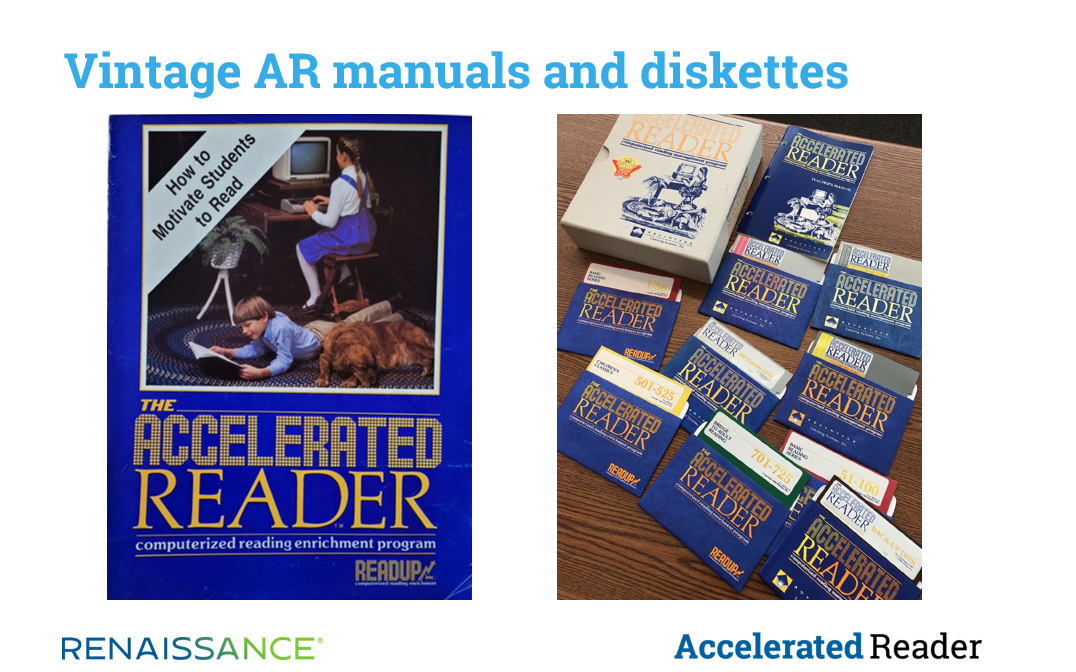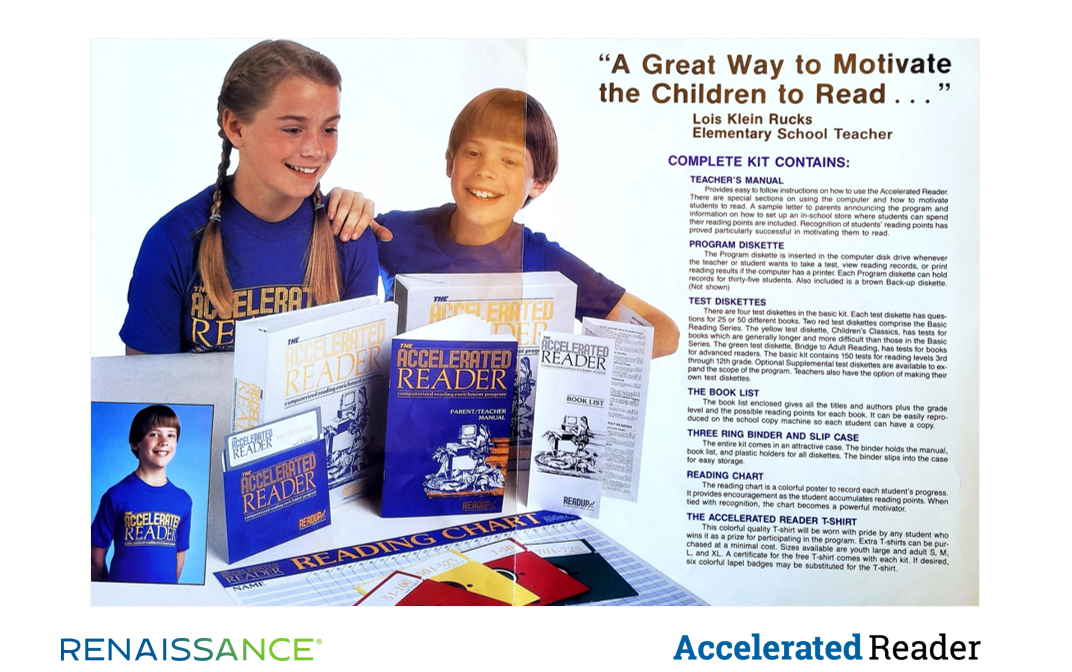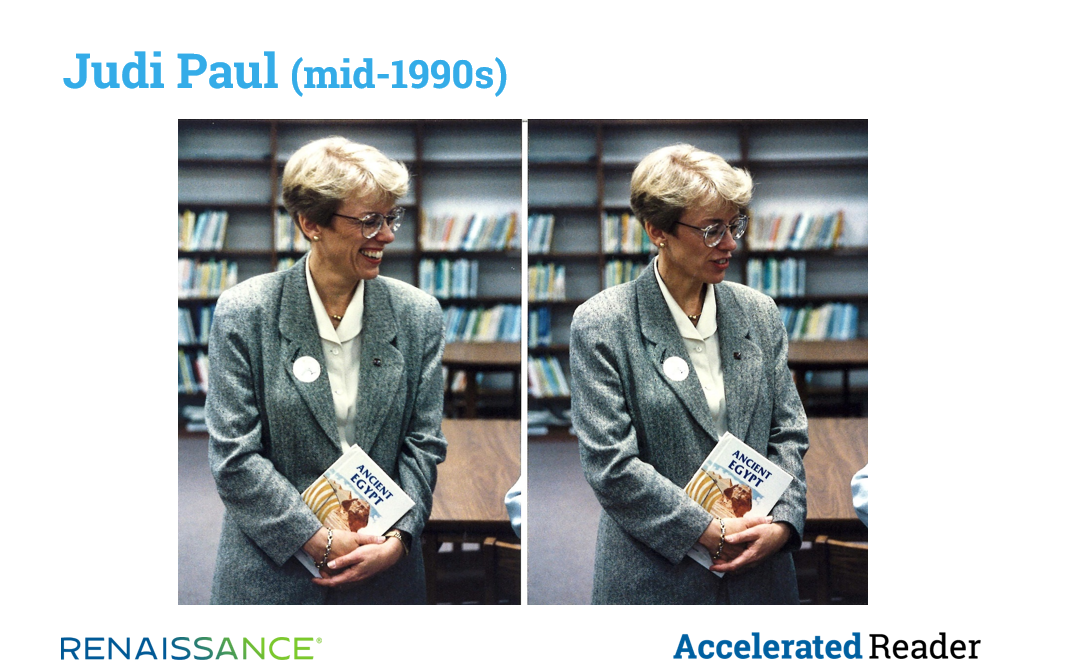April 9, 2021
Life has changed significantly since 1986. Back then, Top Gun and Crocodile Dundee ruled at the box office; Tom Clancy and Judith Krantz had best-selling novels; the Commodore 64 and Apple McIntosh were popular computers; and a talk show called Oprah first hit the airwaves.
That same year, educator Judi Paul launched a program called Accelerated Reader, which is now used in thousands of schools and districts around the world. In an earlier blog, we shared a video—originally distributed on VHS!—of Judi telling the Accelerated Reader story. Recently, we had the chance to discuss AR’s impact with Judi and with Renaissance employees both past and present. Here are some highlights from our conversation.
What are your memories of Accelerated Reader’s early days?
Judi Paul: People sometimes ask me if it was exciting to start an edtech company in the 1980s. To be honest, it was terrifying! I was a teacher and a mother. I’d never worked in an office before, much less run my own business.
When I created Accelerated Reader, I thought that my children would use it, and maybe—someday—my grandchildren. I wrote the first 300 reading comprehension quizzes myself, mostly by checking out books from the local library. Once I started selling AR to schools, I saw the downside of this. I would occasionally get letters from educators about the wording of a particular quiz question, and I’d have to go back to the library to consult the book—hoping that nobody else had checked it out!
At the time, it surprised me that many people—including a lot of parents—didn’t recognize the importance of daily reading practice. They thought that once children learned how to read, they basically had what they needed. But this clearly isn’t the case. Nobody would try to run a marathon without training beforehand. And we can’t expect students to read long, complex texts when they get to college or into the workforce unless they’ve done a lot of reading in middle and high school, in order to build reading stamina and to learn to read more deeply.
That was my goal when I created Accelerated Reader—knowing that if teachers could motivate students to read more, and that if both teachers and students had ongoing feedback about reading practice, then students could become better and stronger readers. While many “tests” are about failure or limiting access, I always hoped that AR quizzes would be used to help ensure that students were being successful and were growing. I wanted the quizzes to be motivational, to help students succeed, and to let teachers know when they needed to step in.
Melissa Budzinski (Technical Support Supervisor): Judi hired me in 1987, when the company was called Read Up! and was still located in the basement of the Pauls’ home. When Judi would get a phone order for Accelerated Reader, she’d write the information on a notepad, and then sit down at her typewriter to fill out the paperwork. Once she was finished, she’d walk to another part of the basement, where she’d box up the AR floppy disks and manuals to mail to the customer.
We also published an AR newsletter called Horizons. Once we received the printed copies, it was a major operation to stick on the mailing labels, carry the bags up the stairs and out to the station wagon, and then deliver them to the local post office. After we moved out of the basement, we ended up in an office building next door to the post office, which saved us a step!

For those of you who are former educators, what was your first experience with Accelerated Reader?
Carolyn Denny (former Vice President of Strategic Initiatives): I was working as a long-term substitute, teaching PE. Students would come to class carrying books, and I’d have to explain why it wasn’t safe to jump rope and read at the same time. I’d never seen students this motivated—they would literally stand in line waiting to get into the school library.
Later, I was offered a job as a Title I teacher in a neighboring district, and I said that I’d only accept if they implemented AR. Early in the school year, I told my students that they’d be expected to read in the evenings and on weekends. One boy raised his hand and asked if I’d like him to read the phone book or TV Guide, because those were the only reading materials in his household. The first time I took my students to the school library, and they saw all of the choices they had at their reading level, their eyes lit up.
We talk a lot about the achievement gap, but it always struck me that—in the middle grades especially—there is more of an opportunity gap. When students have access to a school library, along with a program like Accelerated Reader to guide them to books and to help them track their progress toward reading goals, they really flourish.
D’Etta Coit (former Regional Vice President): I was a fifth-grade language arts teacher, and quarterly book reports were a big part of my job. This involved taking the kids to the school library to check out a book…only to have them copy long passages—usually from the book’s opening pages—into their book reports. There clearly wasn’t a lot of reading going on.
Our school received Judi’s Horizons newsletter, which never really caught my eye until I saw the headline Never Grade Book Reports Again. I thought, This is the program I’ve been looking for! At that time—1988—it cost $500 to get the program started, but my principal told me there wasn’t any money available. So I applied for a foundation grant, which I used to bring Accelerated Reader into my classroom. And the change was immediate, with kids genuinely reading and enjoying books—something that rarely happened in the days of books reports.
Whenever I moved to a new school, I brought AR with me. I would write a grant request, and then get the librarian and the other teachers on board, because I’d seen the difference the program could make.
Marcy LeMaster (former Renaissance Consultant): I taught in Chicago Public Schools, and I found a box of Accelerated Reader diskettes that the previous teacher had left behind. I used the program in my classroom that first year, but it was only when I attended an AR professional development session that I fully understood everything the program can do.
The second year, I implemented all of the AR best practices—especially around goal-setting—and the results were amazing. In fact, the students did so well on the ITBS high-stakes test that spring that my classroom was audited. This was an inner-city school, and the central office thought the students couldn’t possibly have done so well in reading. So the test was administered again—and this time the students’ scores were even higher.
Shortly after this, I joined Renaissance and began delivering professional development for AR. When the program is implemented with fidelity, it completely changes the culture of reading in a school, as D’Etta and Carolyn have explained.

When you’re asked to describe the impact of Accelerated Reader, does a particular student come to mind?
Marian Staton (former Executive Vice President of Sales): My husband and I recently moved to a new house, and I put something on the Nextdoor app to introduce myself to our neighbors. A few days later, the doorbell rang, and I heard someone ask, “Does Miss Staton live here?” I recognized the voice immediately: a former student who didn’t like to read at all until I introduced her to the Accelerated Reader program. She’s now in her 30s and is still an avid reader. In fact, we now run a city-wide book club together.
When I joined Renaissance in the 1990s, people asked me why I was “leaving” education, since I’d worked as a school librarian for so many years. I said that I wasn’t leaving at all, because I was continuing to work with educators and to help them have the same level of success with AR that I’d had.
Barbara Wright (Senior Renaissance Consultant): I was the principal of a Title I building, where we had a strong reading culture built around AR. One year, we had a new fifth-grade student named Robert, who was a foster child. Early on, he announced that he didn’t like to read, and he wasn’t going to do it.
I worked with Robert’s homeroom teacher and the school librarian. We administered the Star Reading assessment to determine his reading level, and we then used AR to help him choose a book on a topic he was interested in. Once he finished reading, he took his first AR quiz and got an 80 percent. After that, there was no stopping him. That child absolutely blossomed. It was the first time he felt successful in school—and the first time he was able to clearly see his progress over the course of the school year.
Not long after that, I met Judi at a Renaissance event. I asked her about the first AR quiz she ever wrote, and she told me that it was for Adam of the Road, by Elizabeth Gray Vining. I went out and bought a copy of the book, which I still keep next to my desk to inspire me.

Judi, you created Accelerated Reader to inspire your son Alex—who’s here with us today—to read more. How did the program impact him?
Alex Paul: I was the typical middle-school boy, in the sense that I’d rather play with my friends or watch TV than read. I didn’t like school very much, and I didn’t do particularly well. Accelerated Reader gave me my first taste of success, which was clearly Judi’s goal.
Judi Paul: When I was creating Accelerated Reader, I dug out my notes from a children’s literature class I’d taken in college. The basics of AR came from that class, which stressed the importance of letting kids choose books that interest them and are at their reading level. The first AR quizzes that I wrote were for Alex, so they focused on books that a middle-school student would find engaging.
Alex Paul: As I got older and read more, I began to discover new genres and new authors. I remember Judi reading The Hobbit and then the Lord of the Rings trilogy, because I got interested in J.R.R. Tolkien and fantasy. My kids use Accelerated Reader now, and my daughter recently took the quiz on The Hobbit. I know that the quiz has changed since the 1980s, to stay one step ahead of the film adaptation!
Judi Paul: We calculated that by the time Alex started college, he’d read around 100 books in order to help me test new AR quizzes. And this extra reading paid off. He had classmates—some of whom had been high school valedictorians—who struggled in college. They simply weren’t used to reading long, complex texts, or to extracting meaning from those texts.
One of the things that surprised me in 1986 was the number of teachers who asked me where they could buy books. I remember thinking, If anyone knows how to get ahold of books, shouldn’t it be teachers? Certain states—Texas and North Carolina come to mind—provided school librarians with separate budgets, but for many educators, getting books was a real challenge.
Today, we have national bookstore chains, along with digital reading platforms that provide access to books electronically. But many students—especially in high school—would rather spend their time scrolling through their phones. I find myself worrying that with all the distractions today, many students aren’t reading very deeply, and they’re not getting the regular practice they need for future success.
I also worry that they’re missing out on the social-emotional aspects of reading. As I explain in the video, I grew up in a small town in Iowa, and reading really helped me to discover the wider world. Today, I think many people rely on social media for this—not realizing that what they’re seeing is just the surface, with people smiling for the camera as they raise a glass of wine or something.
Reading allows us—adults and children alike—to go beneath the surface, to experience other people’s lives, and to see what they’re thinking and feel what they’re feeling. Reading helps us to understand different viewpoints, to think more deeply about our own beliefs, and perhaps to even change our minds. Reading also shows us that we’re not alone, that other people have felt the same way that we feel and have faced the same challenges that we face.
These are all tremendously important lessons. When I look back at my life, and at my children’s lives, I can’t help but see all of the opportunities that reading has opened for us.
Looking for diverse books to engage your students? Check out the latest edition of What Kids Are Reading, the world’s largest annual study of K–12 student reading habits. And to see everything that today’s Accelerated Reader has to offer, click the button below.










